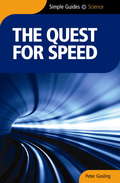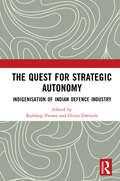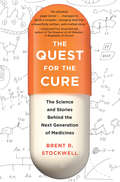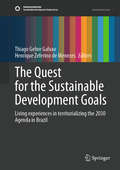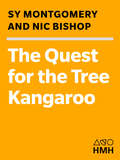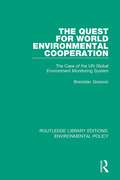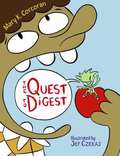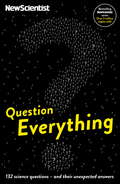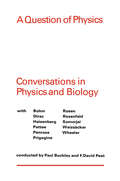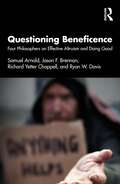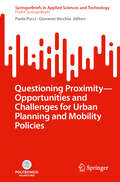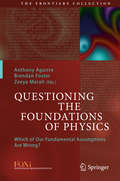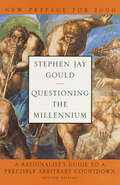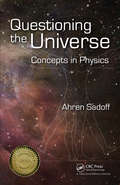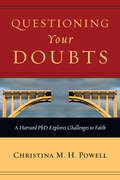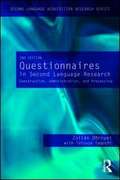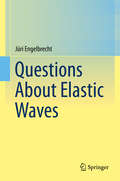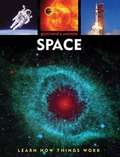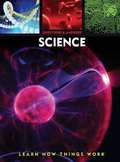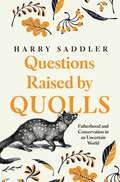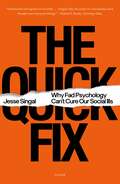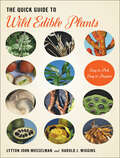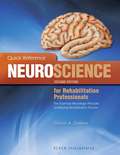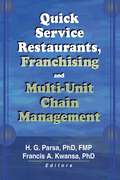- Table View
- List View
Quest For Speed - Simple Guides
by Peter GoslingMan's quest for speed is driven by two ambitions. One is the competitive urge to excel -- to go as fast as possible by any available means, and preferably to go faster than anybody else. The other, more practical, aim is to make travel and transport as swift and efficient as possible. The two are closely linked, since by pushing technology to the limit to achieve the first, we improve performance in the second, with results that continue to shrink the world.In this book Peter Gosling tells the fascinating story of the key scientific discoveries and technological breakthroughs in our drive to conquer distance -- from our earliest crude efforts using animal power and the wheel, to harnessing the wind and the waves, on through the watershed of the Industrial Revolution, rail and steam, the invention of the internal combustion engine, through powered flight to rocketry, and on to space travel. We look at developments on land, sea, and air, and the novel "green" solutions that scientists are exploring in order to meet today's environmental challenges. Along the way we meet some of the remarkable men and women behind these breakthroughs, whose vision and determination have helped to shape the modern world. Written in an engaging, non-technical style, The Quest for Speed captures both the thrill of the race and the adventure of science, and points to the social and cultural changes ahead as technology accelerates the pace of life and transforms the human landscape.SIMPLE GUIDES: SCIENCESimple Guides: Science are user-friendly introductions to the great scientific discoveries of the world. Written by experts in the field, they offer the general reader simple and engaging descriptions of key developments and breakthroughs in different fields of science and technology. * Simple Guides: Science are written in a clear, informal style, using plain, non-technical language to provide accessible introductions to complex scientific theories.* Organized both by theme and chronologically, the books link the major breakthroughs to the lives of their discoverers and inventors.* The clear structure and design enable the general reader to grasp essentials easily. * These guides will appeal to readers with no specific scientific knowledge, yet with a thirst to know more about the world we live in.* The scientific developments and theories are brought to life by descriptions of their social contexts; not only the breakthroughs are described, but also their impact on society and the human story behind the scientists.
The Quest for Strategic Autonomy: Indigenisation of Indian Defence Industry
by Kuldeep Verma Divya Dwivedi Js SodhiThis book offers insights into India’s efforts to become self-reliant in its defence sector. Encompassing a wide range of subjects – such as policy frameworks, technological advancements, economic considerations, and strategic implications – the subject matter explores the diverse aspects of India’s defence industry indigenisation efforts. By gathering the insights of esteemed experts, scholars, and professors, the book also presents an examination of the obstacles and possibilities in this process.The aim of this book is to contribute to the ongoing discussion on the importance of a robust domestic defence industry in strengthening India’s national security, elevating its international standing, and reinforcing its ability to make independent strategic decisions.Print edition not for sale in South Asia (India, Sri Lanka, Nepal, Bangladesh, Pakistan and Bhutan)
The Quest for the Cure: The Science and Stories Behind the Next Generation of Medicines
by Brent StockwellAfter more than fifty years of blockbuster drug development, skeptics are beginning to fear we are reaching the end of drug discovery to combat major diseases. In this engaging book, Brent R. Stockwell, a leading researcher in the exciting new science of chemical biology, describes this dilemma and the powerful techniques that may bring drug research into the twenty-first century.Filled with absorbing stories of breakthroughs, this book begins with the scientific achievements of the twentieth century that led to today's drug innovations. We learn how the invention of mustard gas in World War I led to early anti-cancer agents and how the efforts to decode the human genome might lead to new approaches in drug design. Stockwell then turns to the seemingly incurable diseases we face today, such as Alzheimer's, many cancers, and others with no truly effective medicines, and details the cellular and molecular barriers thwarting scientists equipped with only the tools of traditional pharmaceutical research. Scientists such as Stockwell are now developing methods to combat these complexities-technologies for constructing and testing millions of drug candidates, sophisticated computational modeling, and entirely new classes of drug molecules-all with an eye toward solving the most profound mysteries of living systems and finding cures for intractable diseases. If successful, these methods will unlock a vast terrain of untapped drug targets that could lead to a bounty of breakthrough medicines. Offering a rare, behind-the-scenes look at this cutting-edge research, The Quest for the Cure tells a thrilling story of science, persistence, and the quest to develop a new generation of cures.
The Quest for the Sustainable Development Goals: Living experiences in territorializing the 2030 Agenda in Brazil (Sustainable Development Goals Series)
by Thiago Gehre Galvao Henrique Zeferino de MenezesThe book presents the experiences, complexities, and contradictions of the implementation of the Sustainable Development Goals in Brazil so far. Through chapters from a variety of stakeholders, the book examines national, regional, and local aspects of development in Brazil. The chapters here draw from scientific knowledge and practical experience to take a critical look at what the SDGs mean in a Global South country and what the implications of this are for global development. The book is divided into three sections. The first section addresses the critical political and institutional aspects related to the implementation of the Sustainable Development Goals in Brazil, highlighting advances as well as pitfalls and setbacks. The chapters look at broad questions related to the role of civil society in defining political priorities and strategies to move forward with the SDGs as well as issues involved in incorporating the SDGs at different levels of government and other institutions. The chapters in this section critically address the political and institutional advances as well as barriers to the progress of the SDGs in Brazil. The second section directly addresses progress made toward the SDGs in the context of the political, economic and social variables specific to Brazil. The chapters address critical shortcomings and demands for Brazilian society: the need for improvements in education and employment policies to reduce poverty, the urgent need to increase gender equality and reduce violence, as well as the imperative to strengthen institutions and policies to mitigate climate change and protect the environment. The final section focuses on critically assessing the 2030 Agenda itself and drawing from a Global South IR perspective. The chapters here dialog with decolonial and post-developmentalist perspectives to highlight problems with the agenda and lift up sidelined priorities, presenting yet-unexamined policy solutions and innovations that are currently absent from the global institutional agenda. The Brazilian case is a perfect illustration of how underdevelopment and political instability can constrain the paths to sustainable development, while at the same time social innovations, leverages based on regional dynamics, and strength from social and cultural diversity can drive sustained progress.
The Quest for the Tree Kangaroo: An Expedition to the Cloud Forest of New Guinea (Scientists in the Field Series)
by Sy Montgomery Nic Bishop<P>It looks like a bear, but isn't one. It climbs trees as easily as a monkey- but isn't a monkey, either. It has a belly pocket like a kangaroo, but what's a kangaroo doing up a tree? Meet the amazing Matschie's tree kangaroo, who makes its home in the ancient trees of Papua New Guinea's cloud forest. And meet the amazing scientists who track these elusive animals. <P>[This text is listed as an example that meets Common Core Standards in English language arts in grades 4-5 at http://www.corestandards.org.] <P><P> Winner of the Sibert Honor
The Quest for World Environmental Cooperation: The Case of the UN Global Environment Monitoring System (Routledge Library Editions: Environmental Policy #8)
by Branislav GosovicFirst published in 1992. In 1972, the UN Conference on the Human Environment initiated the process of world environmental cooperation. This study is about GEMS (the Global Environment Monitoring System) which the Conference recommended be set up to generate data and information necessary for worldwide environmental assessment. This book examines the genesis and evolution of GEMS, and the complex task involved in establishing GEMS and making it perform its functions. It relates GEMS to the factors which have shaped the international environmental agenda and cooperation since 1972. In particular, it highlights North-South differences and the problems inherent in the international organizations belonging to the UN system, vis-á-vis the novel and multifaceted challenges involved in dealing with systemic, cross-sectoral nature of global environmental problems. The lessons of GEMS and other issues presented in this book are highly relevant to the continuing efforts to set up effective programmes for ‘earthwatching’ and to promote international environmental cooperation. They also relate more broadly to the challenges of managing global interdependence and to the need to devise supporting organizational structures through reform and strengthening of the UN system. The comprehensive nature of the political and institutional analyses presented in this book make it an academic reference work of lasting value. Its frank tone and willingness to derive prescriptive conclusions will appeal in particular to the many actors engaged in the processes and structures of global multilateral cooperation. The book will be of special use to those interested in environmental issues and international organization
A Question and Answer Guide to Astronomy
by Carol Christian Roy Jean-RenéAre we alone in the Universe? Was there anything before the Big Bang? Are there other universes? What are sunspots? What is a shooting star? Was there ever life on Mars? This book answers the fascinating questions that we have been asking ourselves for hundreds of years. Using non-technical language, the authors summarize current astronomical knowledge, taking care to include the important underlying scientific principles. Plentiful color illustrations, graphs and photographs lend further weight to their simple yet meticulously written explanations. An extensive bibliography allows you to pursue or recap on the subjects that rouse your particular interest. Dip in to discover and learn fascinating facts about our Solar System and the Universe beyond!
Question Everything: 132 science questions -- and their unexpected answers
by New ScientistAll science begins with questions... - Why is the night sky black, even though it's full of stars? - How do pebbles skim on water? - Why doesn't your own snoring wake you up? - And why is the Large Hadron Collider so ... er ... large? And as these intriguing, imaginative and occasionally bonkers questions and answers drawn from New Scientist magazine's archives show: question everything and you might find your way to amazing, unexpected insights into our minds, bodies and the universe, and the science behind the scenes that keeps them ticking.As you would expect from New Scientist, this is top-flight science at its most accessible, unpredictable and entertaining. This latest mind-bending addition to the No. 1 bestselling series will fascinate 'Last Word' fans and new readers alike.
A Question of Physics: Conversations in Physics and Biology
by F. David Peat Paul BuckleyThis book contains interviews with physicists, biologists, and chemists who have been involved in some of the most exciting discoveries in modern scientific thought. The conversations--with Bohm, Pattee, Penrose, Rosen, Rosenfeld, Somorjai, Weizsäcker, Wheeler, and Nobel prizewinners Heisenberg, Dirac, and Prigogine--explore issues which have shaped modern physics and those which hint at what may form the next scientific revolution.The discussions range over a set of basic problems in physical theory and their possible solutions--the understanding of space and time, quantum and relativity theories and recent attempts to unite them--and deal with related questions in theoretical biology. The approach is non-technical, with an emphasis on the assumptions of modern science and their implications for understanding the world we live in.The book, which originated in a highly successful radio series, provides a vivid first-hand account of some of the astounding and perplexing developments in modern science, a rare overview that will intrigue the informed non-scientist and the scientist alike.
Questioning Beneficence: Four Philosophers on Effective Altruism and Doing Good
by Samuel Arnold Jason F. Brennan Richard Yetter Chappell Ryan W. DavisEffective Altruism is a movement and a philosophy that has reinvigorated the debate about the nature of beneficence. At base, it is the consistent application of microeconomic principles to beneficent action. The movement has exposed that many forms of giving do little good (or do active harm), but others do tremendous good.Questioning Beneficence uses Effective Altruism as a launch pad to ask hard questions about beneficence more generally. Must we be Effective Altruists, or are Effective Altruism and the ideas driving the movement a mistake? How much should we give—if anything— and how should we give it? What are the respective roles of different kinds of institutions? Is charity anti-democratic and do billionaire philanthropists have too much power? Is Effective Altruism just utilitarianism in disguise?Questioning Beneficence is written by four philosophers, each with distinct points of view. It introduces a new standard for debating ideas in philosophy as each author poses and answers three questions and each of his three co-authors responds to those questions in turn. Finally, the first author replies to his co-authors’ responses. Throughout the book, there is a spirit of curiosity, intellectual risk taking, and truth-seeking, rather than point-scoring and one-upmanship. This book demonstrates what open-minded, real dialogue on an important issue can be at its very best.Key Features: Introduces a new roundtable format for philosophical debates: each of four authors takes the lead in constructing and answering three questions, each co-author then responds, and the first author then replies to the others’ responses. Explores salient philosophical questions raised by beneficence, like Can philanthropy be undemocratic? Why are people so bad at charity and what can we do about it? How important is beneficence compared to other values? Can Effective Altruism be part of a meaningful moral life? Consistently written in a clear and engaging style, suitable for both undergraduate students and curious general readers
Questioning Proximity - Opportunities and Challenges for Urban Planning and Mobility Policies (SpringerBriefs in Applied Sciences and Technology)
by Paola Pucci Giovanni VecchioThe book discusses some of the issues related to proximity, challenges an acritical use of the concept and highlights several dimensions that may better frame the actual contribution of proximity to urban and mobility planning in different places. The contributions address the conditions required for ensuring accessibility by proximity and the different planning dimensions that can support its promotion, addressing issues related to the inclusiveness of this model, as well as the scalability and metrics of proximity we need to deal with in several different contexts. The first part of the book introduces some experimental approaches aimed at operationalising accessibility by proximity, while the second part discusses several planning issues related to the implementation of proximity at different scales.
Questioning the Foundations of Physics
by Anthony Aguirre Brendan Foster Zeeya MeraliThe essays in this book look at way in which the fundaments of physics might need to be changed in order to make progress towards a unified theory. They are based on the prize-winning essays submitted to the FQXi essay competition ?Which of Our Basic Physical Assumptions Are Wrong, which drew over 270 entries. As Nobel Laureate physicist Philip W. Anderson realized, the key to understanding nature's reality is not anything ?magical?, but the right attitude, ?the focus on asking the right questions, the willingness to try (and to discard) unconventional answers, the sensitive ear for phoniness, self-deception, bombast, and conventional but unproven assumptions. 'The authors of the eighteen prize-winning essays have, where necessary, adapted their essays for the present volume so as to (a) incorporate the community feedback generated in the online discussion of the essays, (b) add new material that has come to light since their completion and (c) to ensure accessibility to a broad audience of readers with a basic grounding in physics. The Foundational Questions Institute, FQXi, catalyzes, supports, and disseminates research on questions at the foundations of physics and cosmology, particularly new frontiers and innovative ideas integral to a deep understanding of reality, but unlikely to be supported by conventional funding sources.
Questioning the Millennium: A Rationalist's Guide to a Precisely Arbitrary Countdown
by Stephen Jay GouldIn this new edition of Questioning the Millennium, best-selling author Stephen Jay Gould applies his wit and erudition to one of today's most pressing subjects: the significance of the millennium. In 1950 at age eight, prompted by an issue of Life magazine marking the century's midpoint, Stephen Jay Gould started thinking about the approaching turn of the millennium. In this beautiful inquiry into time and its milestones, he shares his interest and insights with his readers. Refreshingly reasoned and absorbing, the book asks and answers the three major questions that define the approaching calendrical event. First, what exactly is this concept of a millennium and how has its meaning shifted? How did the name for a future thousand-year reign of Jesus Christ on earth get transferred to the passage of a secular period of a thousand years in current human history? When does the new millennium really begin: January 1, 2000, or January 1, 2001? (Although seemingly trivial, the debate over this issue tells an intriguing story about the cultural history of the twentieth century.) And why must our calendars be so complex, leading to our search for arbitrary regularity, including a fascination with millennia? This revised edition begins with a new and extensive preface on a key subject not treated in the original version.As always, Gould brings into his essays a wide range of compelling historical and scientific fact, including a brief history of millennial fevers, calendrical traditions, and idiosyncrasies from around the world; the story of a sixth-century monk whose errors in chronology plague us even today; and the heroism of a young autistic man who has developed the extraordinary ability to calculate dates deep into the past and the future. Ranging over a wide terrain of phenomena--from the arbitrary regularities of human calendars to the unpredictability of nature, from the vagaries of pop culture to the birth of Christ--Stephen Jay Gould holds up the mirror to our millennial passions to reveal our foibles, absurdities, and uniqueness--in other words, our humanity.
Questioning the Universe: Concepts in Physics (Discovering Physics)
by Ahren SadoffWINNER 2009 CHOICE AWARD OUTSTANDING ACADEMIC TITLE! The typical introduction to physics leaves readers with the impression that physics is about 30 different, unconnected topics such as motion, forces, gravity, electricity, light, heat, energy, and atoms. More often than not, these readers are left to conclude that physics is mostly about boring,
Questioning Your Doubts: A Harvard PhD Explores Challenges to Faith
by Christina M. PowellHow can we know if God is real? Does God truly care about us? Why does God create people he knows will reject him? Why did God allow my friend to become a rape victim? Should I switch jobs? Is this person the one I should marry? If you have pondered these doubts, you are not alone. Sometimes we have intellectual questions about the plausibility of God. Other times we go through difficult life experiences that cause us to question our faith. Sometimes we simply struggle feeling confident with day-to-day decisions. Christina Powell knows what it's like to grapple seriously with challenges to faith. A trained scientist and cancer researcher, she struggled with the mysterious claims of a God who exists beyond what the scientific method could detect. Using personal stories from her own life, she explores how faith can be rooted in rationality, knowledge and facts, while coming to recognize the limits of science in evaluating matters of faith. Asking good questions can help us clarify and refine our faith. We can think critically about our doubts and learn to discern the true and the good. Powell probes the hidden factors that fuel our doubts to help us move beyond skepticism, disillusionment or painful life circumstances. We can live deeper into our questions in the context of Christian community. Ultimately we can work through challenges to faith and find a renewed confidence in our beliefs. It's okay to question your faith. But don't stop there. Question your doubts as well.
Questionnaires in Second Language Research: Construction, Administration, and Processing
by Zoltan Dornyei Tatsuya TaguchiQuestionnaires in Second Language Research: Construction, Administration, and Processing is the first guide in the second language field devoted to the question of how to produce and use questionnaires as reliable and valid research instruments. It offers a thorough overview of the theory of questionnaire design, administration, and processing, made accessible by concrete, real-life second language research applications. This Second Edition features a new chapter on how an actual scientific instrument was developed using the theoretical guidelines in the book, and new sections on translating questionnaires and collecting survey data on the Internet. Researchers and students in second language studies, applied linguistics, and TESOL programs will find this book invaluable, and it can also be used as a textbook for courses in quantitative research methodology and survey research in linguistics, psychology, and education departments.
Questions About Elastic Waves
by Jüri EngelbrechtThis book addresses the modelling of mechanical waves by asking the right questions about them and trying to find suitable answers. The questions follow the analytical sequence from elementary understandings to complicated cases, following a step-by-step path towards increased knowledge. The focus is on waves in elastic solids, although some examples also concern non-conservative cases for the sake of completeness. Special attention is paid to the understanding of the influence of microstructure, nonlinearity and internal variables in continua. With the help of many mathematical models for describing waves, physical phenomena concerning wave dispersion, nonlinear effects, emergence of solitary waves, scales and hierarchies of waves as well as the governing physical parameters are analysed. Also, the energy balance in waves and non-conservative models with energy influx are discussed. Finally, all answers are interwoven into the canvas of complexity.
Questions and Answers: About Space
by CapellaSPACE is full of incredible images and mind-blowing facts about the solar system, galaxies, satellites, and much more! Readers will be fascinated to learn about everything from shooting stars to space travel. Is it possible for humans to live in space? How many starts are there in the universe? How did the planets get their names? SPACE has the answers to all of these questions and many more!
Questions and Answers, Science: Learn How Things Work
by Ella Fern Fiona Tulloch Alex WoolfQuestion and answer format covering: Origin of life, matter, light, sound, heat, electricity, magnets, forces and motion, land, air, and water transport. Detailed explanations and beautiful illustrations. Reading level 4th grade and up.
Questions Raised by Quolls
by Harry SadlerQuestions Raised By Quolls is an eloquent examination of extinction and conservation set against the backdrop of global climate change. From his own family lineage, Harry reveals how the prosperity of the human race runs parallel with the decline of the natural world. Evocative and challenging, this eulogy to lost species will force you to question your place in the vast interconnected web of life.
The Quick Fix: Why Fad Psychology Can't Cure Our Social Ills
by Jesse SingalAn investigative journalist exposes the many holes in today’s bestselling behavioral science, and argues that the trendy, TED-Talk-friendly psychological interventions that are so in vogue at the moment will never be enough to truly address social injustice and inequality.With their viral TED talks, bestselling books, and counter-intuitive remedies for complicated problems, psychologists and other social scientists have become the reigning thinkers of our time. Grit and “power posing” promised to help overcome entrenched inequalities in schools and the workplace; the Army spent hundreds of millions of dollars on a positive psychology intervention geared at preventing PTSD in its combat soldiers; and the implicit association test swept the nation on the strength of the claim that it can reveal unconscious biases and reduce racism in police departments and human resources departments. But what if much of the science underlying these blockbuster ideas is dubious or fallacious? What if Americans’ longstanding preference for simplistic self-help platitudes is exerting a pernicious influence on the way behavioral science is communicated and even funded, leading respected academics and the media astray? In The Quick Fix, Jesse Singal examines the most influential ideas of recent decades and the shaky science that supports them. He begins with the California legislator who introduced self-esteem into classrooms around the country in the 1980s and the Princeton political scientist who warned of an epidemic of youthful “superpredators” in the 1990s. In both cases, a much-touted idea had little basis in reality, but had a massive impact. Turning toward the explosive popularity of 21st-century social psychology, Singal examines the misleading appeal of entertaining lab results and critiques the idea that subtle unconscious cues shape our behavior. As he shows, today’s popular behavioral science emphasizes repairing, improving, and optimizing individuals rather than truly understanding and confronting the larger structural forces that drive social ills. Like Anand Giridharadas’s Winners Take All, The Quick Fix is a fresh and powerful indictment of the thought leaders and influencers who cut corners as they sell the public half-baked solutions to problems that deserve more serious treatment.
The Quick Guide to Wild Edible Plants: Easy to Pick, Easy to Prepare
by Lytton John Musselman Harold J. WigginsField-to-table cuisine! Connect with (and eat) the diverse flora around us.A recent rise in the popularity of urban farming, farmers’ markets, and foraging from nature means more people are looking for information about plants. In The Quick Guide to Wild Edible Plants, botanists Lytton John Musselman and Harold J. Wiggins coach you on how to safely identify, gather, and prepare delicious dishes from readily available plants—and clearly indicate which ones to avoid.More than 200 color illustrations, accompanied by detailed descriptions, will help you recognize edible plants such as nettles, daylilies, river oats, and tearthumbs. For decades, Musselman and Wiggins have taught courses on how to prepare local plants, and their field-to-table recipes require only a few, easily found ingredients. They offer instructions for making garlic powder out of field garlic and turning acorns into flour for Rappahannock Acorn Cakes. To toast your new skill, they even include recipes for cordials. The Quick Guide to Wild Edible Plants is a great gift for the beginning naturalist and the perfect addition to every serious forager’s library.
Quick Reference Neuroscience For Rehabilitation Professionals: The Essential Neurologic Principles Underlying Rehabilitation Practice
by Sharon GutmanQuick Reference NeuroScience for Rehabilitation Professionals: The Essential Neurologic Principles Underlying Rehabilitation Practice, Second Edition is a user-friendly, comprehensive text that specifically addresses the key information needed to understand the neuroscience of clinical rehabilitation. This updated Second Edition is designed to provide complex information in a quick, easy-to-use format that is beneficial to students and rehabilitation professionals. Dr. Sharon A. Gutman designed Quick Reference NeuroScience for Rehabilitation Professionals, Second Edition to provide easy-to-understand explanations of complex neurologic phenomena. The text describes basic neuroanatomical structures and functions, neuropathology underlying specific clinical conditions, and theories supporting clinical treatment. Features of the Second Edition: • User-friendly, bulleted outline format • Italicized key concepts for easy scanning and identification • Color illustrations to help visualize the location of neuroanatomical structures • New clinical test questions • New text boxes outlining neurologic conditions and treatments • Updated and expanded glossary with both clinical and neurological terms Including accessible information, color illustrations, new test questions, and updated features, Quick Reference NeuroScience for Rehabilitation Professionals: The Essential Neurologic Principles Underlying Rehabilitation Practice, Second Edition is a dynamic text for all students and clinicians in occupational therapy, physical therapy, and other areas of rehabilitation.
Quick Service Restaurants, Franchising, and Multi-Unit Chain Management
by Francis A Kwansa H.G. ParsaLearn about new strategies to improve service, quality, and profitability for quick service restaurants!Quick Service Restaurants, Franchising, and Multi-Unit Chain Management examines a variety of issues pertaining to quick service restaurants. Quick-service restaurants (QSR) are the dominant sector of the foodservice industry and a one-hundred-billion-dollar industry. Since their inception in the 1920s, quick-service restaurants have become one of the cultural icons of America. This informative book contains vital information on: growth, change and strategy in the international foodservice industry food safety as an international problem and the formation of outreach committees to combat the challenges faced globally food consumption patterns and the driving forces that influence consumer food preferences the differences between mature and younger customers&’ expectations and experiences in QSRs, casual, and fine dining restaurants consumer attitudes toward airline food adding quick-service meals to airplane menus factors influencing parental patronage of QSRs a case study on how Billy Ingram, founder of White Castle restaurants, made the hamburger a staple on American menus
